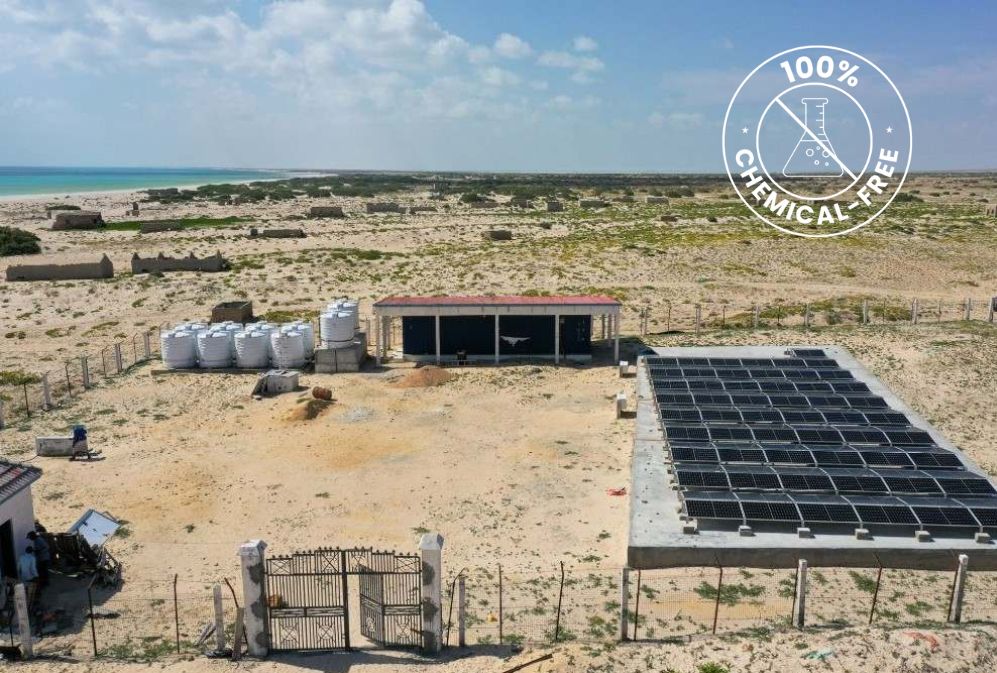Clean drinking water is a human right. But, it has become an expensive commodity for many communities in different parts of the world. If high water bills and constant water supply disruptions are bothering your community, it’s time to consider water desalination systems!
It is no secret that we are heading towards a massive drinking water shortage. The signs are there. Our freshwater sources like rivers and aquifers are depleting by the day. Add to that, climate change is making things worse. This is why we need an alternative.
Haven’t heard of water desalination yet? This guide covers all the key aspects of this innovative solution and how it’s feeding communities as we speak. It is a sustainable and long-term solution for our water crisis. Best of all, we’ve got desalination systems powered by renewable energy!
What is Water Desalination Really?
Seawater is not fit for consumption in its natural state. With water desalination, we can convert seawater to drinking water. It’s not just a cool concept. It is a superb way to use the abundant water in our precious oceans.
Now, how does this work?
There are different ways to remove the saline content in seawater. But, all these techniques ultimately achieve the same thing. Water desalination is filtering out or separating the salt and other particles in seawater and converting it to freshwater.
Seawater desalination has existed for a long time. But, it is only used for large-scale projects headed by the government or corporations as it’s expensive. Now, it’s more accessible for community-level uses with innovative solutions like EWM solar desalination systems!
Why Is Water Desalination Important Today?
Water desalination technology has become important, if not critical today. Our freshwater resources are running out of supply because of overuse and pollution. The global population is increasing every year and so is the demand for water for both commercial and residential use. In fact, it is expected to rise by 55% between 2000 and 2050.
Groundwater, the largest source of freshwater, is becoming less viable. Not only is the supply shrinking, but rising sea levels are also increasing the salt content in aquifers. In the past, communities without easy access to freshwater often relied on methods like rainwater harvesting. But, climate change is turning things around – for the worse. Extreme drought conditions have become common.
Droughts are increasing in frequency and becoming more prolonged around the world, particularly in the Pacific Region. Droughts increase the vulnerability for those communities reliant on rainfall / surface water for freshwater supplies. Desalination takes all the supply uncertainty away.
What are the Top Water Desalination Methods?
Seawater desalination is carried out using different techniques. The two most common options are,
Reverse Osmosis (RO)
Perhaps the most common method is reverse osmosis desalination. This method filters seawater using a semi-permeable membrane. As the seawater or brackish water passes the membrane at high pressure, the salt particles and other contaminants are retained. This way, only clean water goes to the other side.
Even the EWM solar desal system supplied by Bluemont uses reverse osmosis to desalinate water!
Thermal Distillation
Thermal distillation separates the salt content in seawater by allowing the water to boil until it evaporates. Then, the vapour is condensed and collected as fresh water. There are different methods of thermal distillation – like multistage flash distillation, multiple-effect distillation, and vapour compression distillation. But, this technique is not very energy-efficient and it’s also expensive. For this reason, it’s not very popular.

No Chemicals
Only manufacturer in the industry
100% Solar
Hybrid system, can be fully powered by solar energy
Where Is Water Desalination Used?
Water desalination is ideal for communities living in coastal regions. It is widely used in the Middle East and Africa, where freshwater sources are limited. It is also increasingly being used in Australia. Water desalination is a climate-resistant solution for dry zones. Many governments are also using it to solve the urban water crisis!

If you are living in Australia, New Zealand or the Pacific Islands, you now have access to solar-powered desalination systems.
Problems Associated with Desalination of Water
You might wonder if water desalination is great, why aren’t more people using it! The biggest barrier to accessibility is the cost.
Conventional desalination plants are expensive and require significant upfront investment. They require infrastructure facilities, land, and more importantly, a lot of energy for operation. For example, reverse osmosis desalination relies heavily on high water pressure enabled by high-volume pumps. Now, imagine the extent of fossil fuels required to get these plants running!
Another issue is the disposal of brine following the water desalination process. It is important to dispose of waste in a way that doesn’t affect the ecosystems.
Best Water Desalination System for Households
Did you know water desalination is possible through systems powered by renewable energy like solar and wind?
Solar desalination overcomes many issues associated with traditional desalination plants. Best of all, they are also available in varying models and sizes to suit different applications. Solar desalination systems by EWM are a cost-effective solution for small and medium-scale applications. From households to businesses, they are being utilized for different purposes today.
It’s not expensive or complicated to handle. The mechanism is simple. EWM desalination units use reverse osmosis technology and are very energy-efficient. Time to say goodbye to hefty utility bills, eh?
What Can I Use Desalinated Water for?
Desalinated water can be used for just about anything you would use fresh water for.
It can fulfill your daily water intake requirements. It’s pure portable drinking water! You can also use it for washing clothes, cooking, cleaning, bathing, and various household needs. If you have a farm or garden, the water can help feed your livestock, nourish your plants, and keep your space thriving.
Another great benefit of a solar-powered desalination unit is that it serves as a reliable backup during emergencies. For instance, if you live in a flood-prone area where water sources become contaminated, you’ll have an easy way to access clean drinking water without any hassle!
Benefits of Water Desalination Technology
Water desalination, especially solar desalination, comes with a lot of benefits.
- Reliable
If you have been dealing with water cuts, you know the struggle! With a water desalination part installed, you can enjoy an uninterrupted water supply to fulfil your daily chores. You can even have it as a backup to use when the main line faces issues. - Eco-friendly
Solar desalination systems by EWM have reduced the carbon footprint of desalination by using nature’s best forces to power up the filtration process. There’s no excess fossil fuel consumption or energy wastage. Just the good ol’ sun! - Easy Set Up and Maintenance
Desalination systems made for small-scale use are easy to set up. EWM systems require minimal setup and are super convenient to operate as well. You can check the water level remotely and keep track of the supply.
Cost of Water Desalination
It’s right to think seawater desalination is a costly affair. But, there are affordable options available in the market today. The cost depends on the size of the plant, the litres of water it can produce, the energy source, and other features like additional filters in the system.
Don’t forget to factor in the installation cost, which will vary based on your property’s terrain and access to seawater.
Get in touch with us to get a quote for installing an EWM solar desalination system for your home or community needs!
How Much Water Does a Desalination Plant Produce?
It really depends on the size of the plant and the desalination technique used. We recommend you speak with the supplier and decide the best option that suits your daily freshwater requirements.
EWM solar desalination units by Bluemont come in varying capacities and they support water production between 5 to 100 m³ per day, or about 5,000 – 100,000 litres per day!
EWM Solar Desalination Systems: The Sustainable Way Forward
Water desalination will soon be a norm for coastal regions. Seawater desalination using a sustainable energy source like solar or wind is a very self-reliant and cheaper option for households.

Have you decided to make the switch?
Then, we highly recommend considering an EWM solar desalination system. It is an eco-friendly solution to the growing water shortage and will ensure your water needs are met without disruptions. Bluemont is the leading supplier of EWM systems in Australia, New Zealand, and the Pacific Islands.
Contact us by emailing sale@avjenvironmental.com or call us at +61 2 9091 0360 to book a consultation or request a quote. Our team will help you select the best option considering your daily water requirements, accessibility and terrain conditions, and budget.
Want to know more about solar desalination? Then, you might want to check these out!
